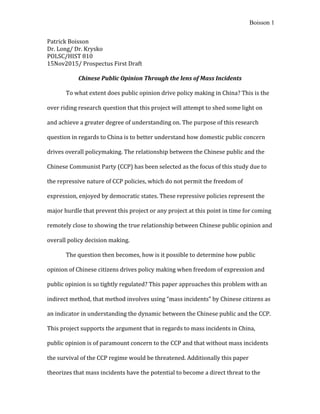More Related Content
Similar to POLSC 810 Final Prospectus
Similar to POLSC 810 Final Prospectus (20)
POLSC 810 Final Prospectus
- 3. Boisson 3
Beginning with Yanqi Tong and Shaohua Lei’s “Large Mass Incidents and
Government Responses in China” the major theme focuses on identifying different
types of mass incidents experienced in China while additionally identifying which
type of mass incident is most threatening to the CCP’s regime in China. Additionally
the authors provide reasoning for how the CCP uses mass incidents as a means of
making institutional and political reform to ensure social stability in China. This
outlook on how the CCP utilizes mass incidents as a means for survival is incredibly
useful in attempting to understand the role that public opinion plays in policy
reform in China. Additionally the type of mass incidence that the authors provide as
being the actual threat to the CCP’s regime in China is illuminating and helps to
better understand possibly why the CCP is so motivated to control internet traffic.
The authors categories of large scale mass incidents involve: labor disputes,
land and relocation disputes, disturbances and riots, ethnic conflicts, protests from
the middle class, and disappearing types.1 The importance of this categorization lies
with authors contributing to the overall definition of mass incidents. According to
the Ministry of Public Security, large-scale mass incidents refer to a mass incident
with more than 500 participants.2 This categorization helps the reader understand
the context of specific large-scale incidents opposed to simply knowing that more
than 500 citizens were apart of the incident itself.
1 Tong, Yanqi, and Shaohua Lei. "Large-scale mass incidents and government responses
in China." International Journal of China Studies 1, no. 2 (2010): 487-508.
2
Tong, Yanqi, and Shaohua Lei. "Large-scale mass incidents and government responses
in China." International Journal of China Studies 1, no. 2 (2010): 487-508.
- 4. Boisson 4
The key importance of these categories and the data that they yield lies with
the authors conclusions. Those conclusions being that the overall upsurge of large-
scale mass incidents in recent years is a reflection of increased social tensions in
China due to the structural changes of state owned enterprises, widening income
disparities, and growing rights awareness on the part of the population. Additionally
the most threatening of these categories is the non-economic interest driven mass
incidents that fall under the disturbances and riots category.3 This is because mass
incidents that are triggered by economic grievances have clear demands that have
the ability to be settled quickly by the parties involved or if the central government
needs to step in if necessary to help with funding. Social disturbances are the most
threatening to the regime in China because a social disturbance involves the
majority of the participants not having a particular demand or direct interest, but
simply wanting to disturb the public order while a riot is the more radical form of
disturbance in which gathering crowds are committing acts of violence.4
The final conclusion is that the root cause of the social tension and distrust of
the government lies with poor local governance.5 The importance behind the poor
governance at the local level is in how the central government utilizes these mass
incidents as a means to evaluate how local governments perform under pressure.
3
Tong, Yanqi, and Shaohua Lei. "Large-scale mass incidents and government responses
in China." International Journal of China Studies 1, no. 2 (2010): 487-508.
4
Tong, Yanqi, and Shaohua Lei. "Large-scale mass incidents and government responses
in China." International Journal of China Studies 1, no. 2 (2010): 487-508.
5
Tong, Yanqi, and Shaohua Lei. "Large-scale mass incidents and government responses
in China." International Journal of China Studies 1, no. 2 (2010): 487-508.
- 7. Boisson 7
The last article by Ashley Esarey and Xiao Qiang focuses less on mass
incidents and more on how the CCP has experienced three phases of information
regime change while also highlighting how the CCP controls the Internet to control
and guide political expression. The key conclusion from this analysis is that mass
self communication via blogs and other media enables freedom of speech and
political participation, even in authoritarian regimes. This applies directly to China
because due to China’s vast size, activists had difficulty creating linkages with
activists elsewhere, who may have had similar concerns or been willing to support a
popular movement. Through the use of modern technology like blogs, online video
clips, email, and text messages, activists can utilize interactive relationships to
garner broad support for their causes.10
The additional piece of data worth mentioning is in reference to “mass
Internet incidents” which involve one million or more visits to a web site by users.
In 2003, there were two mass Internet incidents and by 2009 the number of mass
Internet incidents had risen to 12.11 The significance of these large-scale mass
Internet incidents is not only are they increasing in frequency but that their effects
are very real in forcing change. This is apparent in their contributions to: the
abolition of the custody and repatriation system for migrant workers, the halting of
state-sponsored urban development projects, the overhaul of the criminal justice
system to reduce abuse of inmates in prisons, the reconsideration of a murder case
10
Esarey, Ashley, and Qiang Xiao. "Digital communication and political change in
China." International Journal of Communication 5 (2011): 22.
11
Esarey, Ashley, and Qiang Xiao. "Digital communication and political change in
China." International Journal of Communication 5 (2011): 22.
